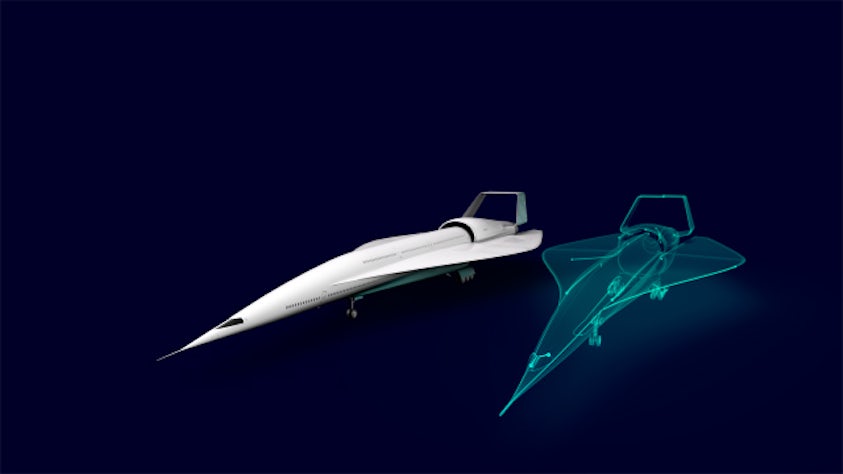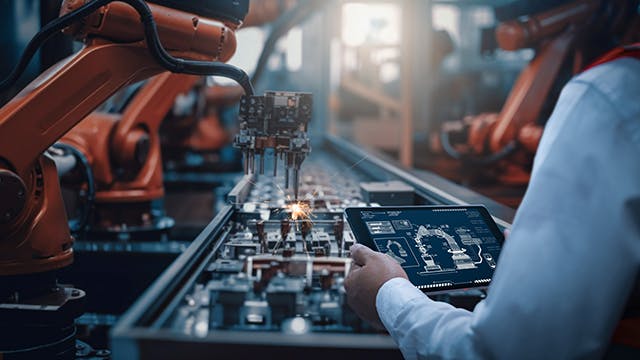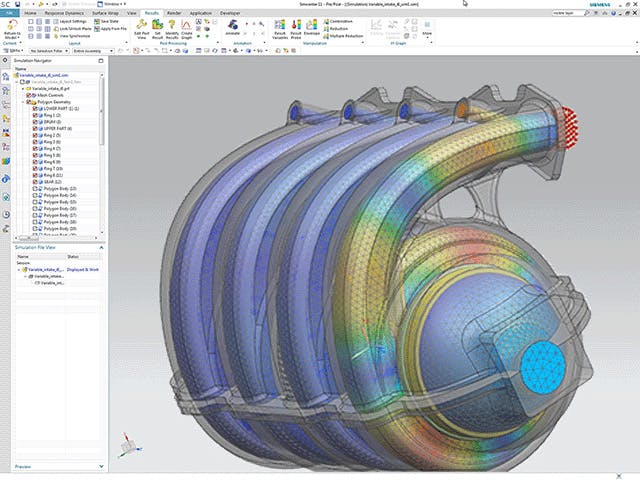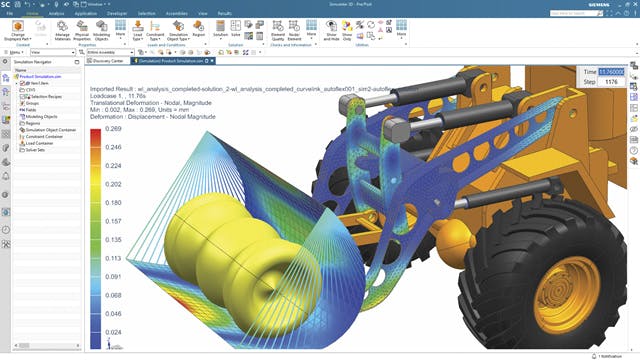W przeciwieństwie do tradycyjnych cyfrowych bliźniaków, które są używane głównie do monitorowania i analizy, wykonywalne cyfrowe bliźniaki są aktywnymi, dynamicznymi modelami, które mogą reagować na dane wejściowe, symulować scenariusze i podejmować decyzje autonomicznie lub z udziałem człowieka. Wykonywalna cyfrowa reprezentacja bliźniacza (lub xDT). Mówiąc prościej, xDT to cyfrowy bliźniak na chipie. xDT wykorzystuje dane z (stosunkowo) niewielkiej liczby czujników wbudowanych w produkt fizyczny do przeprowadzania symulacji w czasie rzeczywistym przy użyciu modeli zredukowanego rzędu. Na podstawie tych niewielkich liczb czujników może przewidzieć stan fizyczny w dowolnym punkcie obiektu (nawet w miejscach, w których niemożliwe byłoby umieszczenie czujników).
Symulacja i interakcja w czasie rzeczywistym
Wykonywalne cyfrowe bliźniaki (xDT) są w stanie symulować zachowanie i wydajność fizycznego zasobu lub systemu w czasie rzeczywistym. Mogą reagować na dane wejściowe, symulować różne warunki pracy i dynamicznie wchodzić w interakcje z systemami zewnętrznymi lub użytkownikami.
Autonomia i podejmowanie decyzji
Wykonywalne cyfrowe bliźniaki (xDT) mogą podejmować decyzje autonomicznie w oparciu o predefiniowane reguły, algorytmy lub modele uczenia maszynowego. Mogą analizować dane, przewidywać wyniki i podejmować działania w celu optymalizacji wydajności lub reagowania na zmieniające się warunki.
Sterowanie w pętli zamkniętej
Wykonywalne cyfrowe bliźniaki (xDT) często działają w systemie sterowania w pętli zamkniętej, w którym dane w czasie rzeczywistym z czujników i elementów wykonawczych są przekazywane z powrotem do wirtualnego modelu w celu dostosowania parametrów, optymalizacji wydajności i utrzymania pożądanych warunków pracy.
Analiza predykcyjna i optymalizacja
Wykonywalne cyfrowe bliźniaki (xDT) wykorzystują analizy predykcyjne i techniki optymalizacji do prognozowania przyszłych zachowań, identyfikowania potencjalnych problemów lub możliwości oraz zalecania działań mających na celu poprawę wydajności lub ograniczenie ryzyka.
Integracja z technologiami IoT i AI
Wykonywalne cyfrowe bliźniaki (xDT) wykorzystują czujniki Internetu rzeczy (IoT), łączność i algorytmy sztucznej inteligencji (AI) do zbierania danych w czasie rzeczywistym, analizowania złożonych wzorców i podejmowania świadomych decyzji. Mogą również obejmować modele uczenia maszynowego do zachowań adaptacyjnych i ciągłego doskonalenia.
Dynamiczna adaptacja i uczenie się
Wykonywalne cyfrowe bliźniaki (xDT) są w stanie uczyć się na podstawie doświadczeń i dostosowywać się do zmian w środowisku lub warunkach operacyjnych w czasie. Mogą stale aktualizować swoje modele, parametry i strategie w oparciu o nowe dane i informacje zwrotne.
Wykonywalne cyfrowe bliźniaki znajdują zastosowanie w różnych branżach, w tym w produkcji, energetyce, transporcie, opiece zdrowotnej i inteligentnych miastach. Umożliwiają konserwację predykcyjną, autonomiczną pracę, optymalizację procesów i wspomaganie decyzji w złożonych systemach, w których monitorowanie i sterowanie w czasie rzeczywistym mają kluczowe znaczenie. Ogólnie rzecz biorąc, wykonywalne cyfrowe bliźniaki stanowią kolejny krok w ewolucji technologii cyfrowych bliźniaków, oferując rozszerzone możliwości symulacji w czasie rzeczywistym, podejmowania decyzji i optymalizacji zasobów fizycznych i systemów. Wykonywalny cyfrowy bliźniak to zaawansowana forma cyfrowego bliźniaka, która nie tylko reprezentuje wirtualną replikę fizycznego zasobu lub systemu, ale także ma możliwość wykonywania, symulowania i interakcji z wirtualnym modelem w czasie rzeczywistym.
Modele oparte na fizyce
Wykonywalny cyfrowy bliźniak oparty na fizyce opiera się na modelach matematycznych, które opisują fizyczne zachowanie replikowanego systemu. Modele te są zazwyczaj oparte na podstawowych zasadach fizyki, takich jak mechanika, termodynamika, dynamika płynów, elektromagnetyzm i tak dalej. Rozwiązując równania, które rządzą tymi zjawiskami fizycznymi, cyfrowy bliźniak może symulować zachowanie systemu świata rzeczywistego w środowisku wirtualnym.
Symulacja procesów fizycznych
Cyfrowy bliźniak symuluje procesy fizyczne i interakcje w systemie przy użyciu modeli opartych na fizyce. Pozwala to przewidzieć, jak system będzie się zachowywał w różnych warunkach pracy, wejściach i scenariuszach.
Symulacja w czasie rzeczywistym
Wykonywalny cyfrowy bliźniak oparty na modelach fizycznych może symulować zachowanie systemu fizycznego w czasie rzeczywistym lub zbliżonym do rzeczywistego. Umożliwia to dynamiczną interakcję i podejmowanie decyzji w oparciu o aktualny stan systemu i jego otoczenia.
Sterowanie w pętli zamkniętej
Wykonywalne cyfrowe bliźniaki oparte na fizyce często działają w systemie sterowania w pętli zamkniętej, w którym dane w czasie rzeczywistym z czujników i siłowników są wykorzystywane do dostosowywania parametrów symulacji i kontrolowania zachowania wirtualnego modelu. Dzięki temu cyfrowy bliźniak może utrzymać pożądane warunki pracy i zoptymalizować wydajność.
Walidacja i weryfikacja
Modele oparte na fizyce używane w wykonywalnych cyfrowych bliźniakach muszą zostać zweryfikowane i zweryfikowane, aby zapewnić ich dokładność i niezawodność. Wiąże się to z porównaniem wyników symulacji z rzeczywistymi pomiarami i danymi eksperymentalnymi w celu potwierdzenia, że cyfrowy bliźniak dokładnie odzwierciedla system fizyczny.
Chociaż modelowanie oparte na fizyce jest powszechnie stosowane w wykonywalnych cyfrowych bliźniakach, należy pamiętać, że inne podejścia do modelowania, takie jak modelowanie oparte na danych, modele empiryczne lub modele hybrydowe łączące fizykę i techniki oparte na danych, mogą być również stosowane w zależności od konkretnych wymagań i ograniczeń aplikacji.






